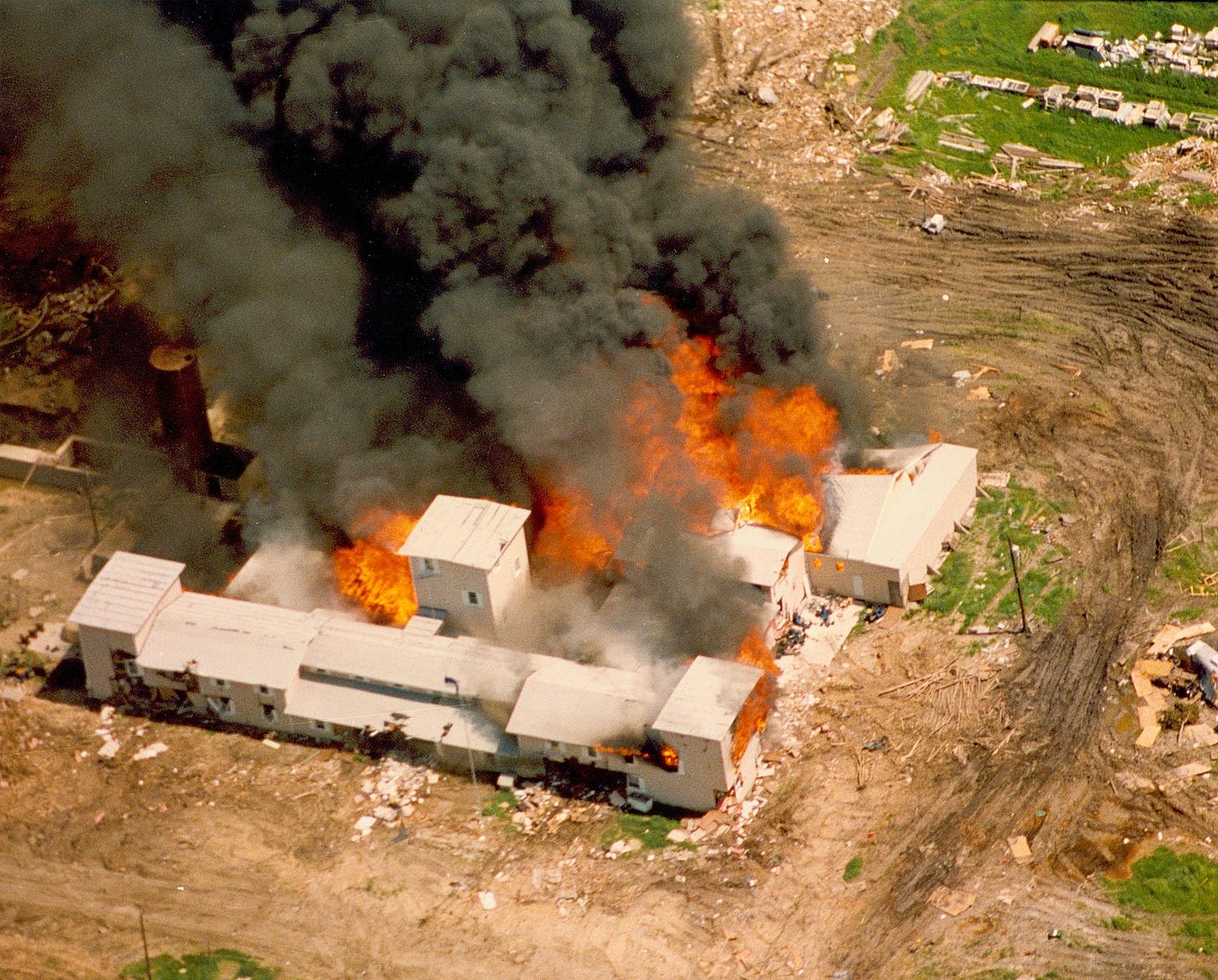WACO TEXAS - Visit To The Branch Davidian Compound
You can still visit the Branch Davidian site outside Waco Texas. In case you aren't old enough to remember it or considering it as stop on your RV route, here is information and photos.
Sponsors:
POTL Board game: BuyPOTL.com
Educational Board Games: Kategize.com
PortBallGame.com
Incredible Medical School
The Branch Davidian Compound
1993 - 2025
Download Your pdf Complete Copy of The Publication
David Koresh, the Branch Davidians, and Waco: Then and Now
David Koresh, born Vernon Wayne Howell in 1959, became one of the most controversial religious leaders in American history due to his association with the Branch Davidians, a religious sect that was an offshoot of the Seventh-day Adventist Church. His leadership culminated in the tragic Waco siege of 1993, a 51-day standoff between his followers and federal law enforcement. This event remains a significant moment in U.S. history, shaping discussions around religious freedom, government authority, and public perception of cults. The impact of the Waco siege and Koresh’s legacy is still felt today, both in the city of Waco, Texas, and beyond.
The Rise of David Koresh
David Koresh’s path to leadership began in the early 1980s when he joined the Branch Davidians, a sect formed in the 1930s by Victor Houteff. The group was based in Waco, Texas, and believed in an imminent apocalypse and the necessity of spiritual preparation for the end times. Koresh, charismatic and persuasive, quickly rose through the ranks of the Branch Davidians, eventually becoming the group’s leader after a bitter power struggle.
Koresh claimed to be the final prophet, interpreting the Bible’s Book of Revelation and positioning himself as the “Lamb of God” destined to lead his followers to salvation. He was also known for his unusual doctrines, which included a belief in polygamy, including marriages to young girls, which he justified through his interpretations of biblical texts. His charismatic teachings drew a dedicated group of followers, some of whom came from as far away as Australia and the United Kingdom to join his community at the Mount Carmel Center, a compound just outside Waco.
Mount Carmel: A Fortress of Faith
Under Koresh’s leadership, the Mount Carmel compound became a self-contained, insular community. It was a place where Koresh’s teachings could be practiced without outside interference. Life at Mount Carmel was highly regulated, with Koresh maintaining strict control over the group’s daily routines, diets, and social interactions. He also began stockpiling weapons, purportedly for self-defense in preparation for the apocalypse he claimed was imminent.
The accumulation of firearms and reports of child abuse and polygamy drew the attention of local authorities and eventually the federal government. The Bureau of Alcohol, Tobacco, and Firearms (ATF) launched an investigation into the Branch Davidians in 1992, suspecting them of illegal weapons possession. This set the stage for the confrontation that would bring the group’s name into the national spotlight.
The Waco Siege: A Tragic Confrontation
On February 28, 1993, the ATF attempted to execute a search warrant at the Mount Carmel compound. The raid quickly turned violent, with a firefight breaking out between the agents and the Branch Davidians. Four ATF agents and six Branch Davidians were killed in the initial exchange. The standoff that followed lasted 51 days and drew intense media scrutiny.
The Federal Bureau of Investigation (FBI) took over the operation, employing psychological warfare tactics, including sleep deprivation, the use of loudspeakers to broadcast disturbing sounds, and cutting off electricity to the compound. Negotiations between the FBI and Koresh continued throughout the siege, with several children and elderly members released over the weeks, but the majority of the group remained inside.
The standoff reached a deadly conclusion on April 19, 1993, when the FBI launched a final assault using tear gas to force the Branch Davidians out. A fire broke out, engulfing the compound. The blaze resulted in the deaths of 76 Branch Davidians, including 25 children. The cause of the fire remains a point of contention, with some survivors and critics arguing that the government was responsible, while the FBI maintains that the Branch Davidians started the fire themselves.
Aftermath and Legacy
The Waco siege had far-reaching implications for both the government and the public. In its immediate aftermath, the incident sparked debates about the use of force by federal authorities, the right to religious freedom, and the characterization of Koresh and his followers as either victims or dangerous extremists. A series of investigations were launched to determine whether the actions of the ATF and FBI were justified, with mixed findings. While some reports criticized the tactics used, others defended the government’s response, stating that the Branch Davidians posed a real threat.
The siege also fueled anti-government sentiment and became a rallying point for militia groups and those who saw the government as overreaching and tyrannical. Timothy McVeigh, one of the perpetrators of the 1995 Oklahoma City bombing, cited Waco as a motivating factor for his attack, which killed 168 people. The siege continues to serve as a potent symbol in discussions about government authority, law enforcement tactics, and civil liberties.
Waco: Then and Now
More than 30 years after the siege, Waco remains a city marked by the events of 1993. The physical scars at the site of the Mount Carmel compound have largely faded, but the emotional and psychological impacts remain palpable. The Branch Davidians, though their numbers have dwindled, still exist as a religious group. Some members continue to live at Mount Carmel, maintaining a memorial to those who died during the siege. The compound itself has become a site of pilgrimage for those interested in the events or seeking to understand the motivations of Koresh and his followers.
In Waco, the narrative around the siege is complex. The city, once known primarily for the standoff, has worked to redefine its identity. It has seen a revival in recent years, thanks in part to popular culture references and the success of HGTV’s “Fixer Upper,” which has brought new attention and tourism to the area. However, for many, the events of 1993 still linger in the background, casting a long shadow over the city’s image.
The Continuing Controversy: Reexamining the Waco Siege
New revelations and interpretations of the Waco siege continue to emerge, keeping the event alive in the public consciousness. Books, documentaries, and films frequently revisit the incident, offering varying perspectives on what happened and why. Some argue that the Branch Davidians were a peaceful group persecuted by a heavy-handed government, while others maintain that Koresh’s actions endangered his followers and warranted the government’s intervention.
In recent years, there has been a renewed focus on understanding the psychological and social dynamics within the Branch Davidian community, exploring the complexities of cult behavior, charismatic leadership, and the power of belief. Scholars and experts on new religious movements have pointed out that while Koresh’s teachings and practices were extreme, they were also deeply rooted in religious traditions and interpretations that were sincerely held by his followers.
Impact on Law Enforcement and Policy
The Waco siege also had a profound impact on federal law enforcement policies and tactics. The incident led to reforms within the ATF and FBI, particularly in how they handle standoffs and situations involving religious or ideological groups. There was an increased emphasis on negotiation, communication, and understanding the cultural and psychological context of the groups involved.
Additionally, the Waco siege led to a broader public awareness of the potential dangers of unchecked government power and the importance of transparency and accountability in law enforcement operations. It remains a cautionary tale for how miscommunication, lack of cultural sensitivity, and aggressive tactics can escalate a situation, resulting in unnecessary loss of life.
The Legacy of David Koresh and the Branch Davidians
David Koresh’s legacy is one of paradox and controversy. To his followers, he remains a messianic figure who died for his beliefs, a prophet whose teachings were misunderstood and maligned by a hostile world. To others, he is viewed as a dangerous cult leader who manipulated his followers and engaged in criminal activities, including child abuse and illegal arms stockpiling.
The Branch Davidians, although diminished in numbers, continue to practice their faith, interpreting the Bible in their unique way and waiting for the return of their messiah. They see themselves not as a cult, but as a persecuted religious minority, steadfast in their beliefs despite the tragic events that decimated their community.
Conclusion
The story of David Koresh, the Branch Davidians, and the Waco siege is a complex tapestry woven from themes of faith, government authority, freedom, and tragedy. It is a reminder of the powerful allure of charismatic leadership, the dangers of fanaticism, and the consequences of confrontations between ideological groups and state power. As Waco continues to rebuild and redefine itself, the legacy of 1993 serves as a stark lesson in the need for understanding, tolerance, and the careful balance between security and liberty in a democratic society.
Happy RVing. Stay Safe & Healthy
Dr, Ricks







